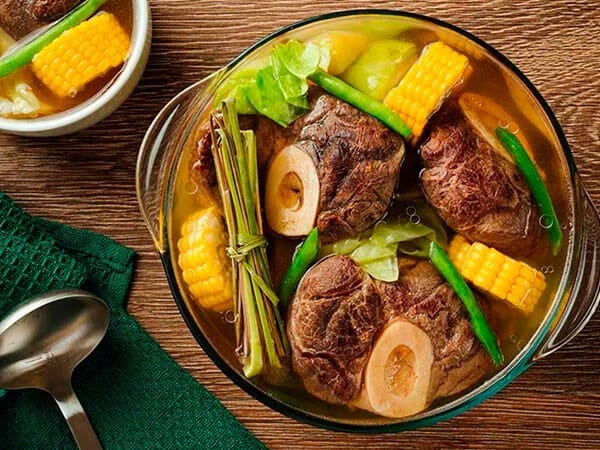Savor Typical Filipino Flavors With Easy-To-Follow Recipes
Checking out traditional Filipino food supplies a special chance to involve with a rich tapestry of tastes and cultural stories. Each dish, from the legendary adobo to the vivid sinigang, tells a tale that mirrors the Philippines' varied culinary heritage. By accepting easy-to-follow dishes, anybody can recreate these cherished meals at home, cultivating links with family and buddies through shared experiences. Recognizing the important active ingredients and strategies is critical for achieving authentic taste. As we discover these culinary traditions, one might wonder how to ideal bring the heat of Filipino friendliness to their very own dining table.

Introduction of Filipino Food
Checking out the lively tapestry of Filipino cuisine exposes a rich cultural heritage affected by different historic and geographical aspects. As a result, Filipino food is an one-of-a-kind blend of Malay, Spanish, Chinese, and American components.
Rice works as the foundation of Filipino meals, typically gone along with by an assortment of vegetables, meats, and seafood. Making use of bold flavors is a hallmark of the cuisine, with components such as garlic, onions, ginger, and soy sauce playing essential duties. The emphasis on common dining reflects the Filipino society of friendliness and household connections.
Road food additionally plays a substantial function in the cooking scene, showcasing neighborhood ingredients and innovative cooking methods. As the Philippines remains to embrace globalization, the blend of conventional and modern-day influences can be seen in modern Filipino recipes, further improving its culinary identity. Filipino food recipes. Overall, Filipino food is a testimony to the country's history, culture, and vivid spirit
Must-Try Standard Dishes
Filipino cuisine is finest experienced via its typical recipes, each using an one-of-a-kind understanding into the country's varied culinary heritage. Amongst the must-try dishes is Adobo, a mouthwatering stew typically made with chicken or pork, marinaded in vinegar, soy sauce, and garlic before being slow-cooked to perfection. Its abundant and tasty flavor profile stands for the heart of Filipino comfort food.
One more legendary meal is Sinigang, a sour soup often prepared with tamarind, tomatoes, and different veggies. This dish can feature pork, shrimp, or fish, and is valued for its revitalizing taste and warming up qualities.
Lechon, a whole baked pig, is a focal point at Filipino parties, recognized for its crispy skin and tender meat. It embodies the festive spirit of Filipino events.
For those desire something wonderful, Halo-Halo is a wonderful treat combining crushed ice, sweetened fruits, jellies, and topped with leche flan and purple yam.
Each of these standard recipes envelops the essence of Filipino society, welcoming anybody to savor the vibrant flavors and abundant background that specify the island chain's culinary landscape.
Step-by-Step Recipes
Cooking authentic Filipino meals in the house can be an enriching experience that brings the vibrant tastes of the Philippines right into your cooking area. With a wide variety of conventional dishes to select from, employing detailed dishes enables both beginner and skilled cooks to master the strategies and tastes essential to Filipino cuisine.
Begin by picking a recipe that intrigues you, such as adobo, sinigang, or lumpia. Each recipe frequently consists of an in-depth component list complied with by clear guidelines, directing you through the food preparation process.
As you proceed, pay attention to food preparation techniques one-of-a-kind to Filipino food, such as sautéing (ginisa) or stewing (nilaga) These techniques can considerably boost the deepness of flavor in your recipes. Timing is important; follow the recommended food preparation times to attain the ideal appearance and taste.
Necessary Active Ingredients and Tips
Often, the secret to grasping Filipino food hinges on understanding and making use of crucial active ingredients that define its unique tastes. Central to several find this recipes are staples like soy sauce, vinegar, garlic, and ginger, which add to the special equilibrium of full-flavored, sour, and sweet notes. Soy sauce acts as a base for marinates and sauces, while vinegar, specifically cane vinegar or coconut vinegar, passes on a tangy brightness that is critical in recipes like adobo.
Rice is an indispensable element of Filipino meals, usually offered along with main dishes to absorb tasty sauces. For a touch of get more credibility, select jasmine or long-grain rice. In addition, making use of fresh fruit and vegetables such as tomatoes, green beans, and eggplants enhances the meal's vibrancy and dietary worth.
Do not overlook the significance of herbs and flavors, such as bay leaves, lemongrass, and chili peppers, which raise the taste account. When food preparation, keep in mind that perseverance is vital-- permitting components to combine together results in richer tastes. Lastly, accept the practice of tasting as you go; this will certainly allow you to change seasonings and accomplish the best equilibrium that identifies Filipino cuisine.
Offering and Taking Pleasure In Filipino Meals
Understanding the nuances of Filipino food prolongs beyond prep work and components; it encompasses the method dishes are served and enjoyed. The Filipino dining experience is characterized by public sharing, look at here advertising a sense of togetherness and party. Commonly, dishes exist in large servings, permitting restaurants to engage in a selection of flavors.
Rice, a staple in Filipino dishes, is typically acted as the structure upon which the various other dishes rest. Coming with viands, such as adobo, sinigang, or lechon, are positioned in the center of the table, welcoming guests to serve themselves. Filipino food recipes. This technique not only cultivates a relaxed environment but also encourages conversations and links amongst restaurants

Conclusion
In conclusion, conventional Filipino cuisine provides an abundant tapestry of tastes and cultural relevance, welcoming exploration through its varied meals. Involving with this vivid cuisine not just enhances the dining experience but likewise maintains and celebrates the heritage of the Filipino people.